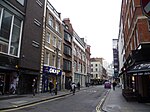Pantheon, London
1772 establishments in England1937 disestablishments in EnglandAssembly roomsBuildings and structures completed in 1772Buildings and structures demolished in 1937 ... and 11 more
Dance venues in EnglandDemolished buildings and structures in LondonDomesEngvarB from October 2013Entertainment in LondonFormer buildings and structures in the City of WestminsterGeorgian architecture in LondonJames Wyatt buildingsNeoclassical architecture in LondonOxford StreetRotundas in the United Kingdom

The Pantheon was a place of public entertainment on the south side of Oxford Street, London, England. It was designed by James Wyatt and opened in 1772. The main rotunda was one of the largest rooms built in England up to that time and had a central dome somewhat reminiscent of the celebrated Pantheon in Rome. It was built as a set of winter assembly rooms and later briefly converted into a theatre. Before being demolished in 1937, it was a bazaar and a wine merchant's show room for over a hundred years. Marks and Spencer's "Oxford Street Pantheon" branch, at 173 Oxford Street now occupies the site.
Excerpt from the Wikipedia article Pantheon, London (License: CC BY-SA 3.0, Authors, Images).Pantheon, London
Oxford Street, London Fitzrovia
Geographical coordinates (GPS) Address Phone number Website Nearby Places Show on map
Geographical coordinates (GPS)
| Latitude | Longitude |
|---|---|
| N 51.5155 ° | E -0.1381 ° |
Address
Marks & Spencer (M&S)
Oxford Street 173
W1D 2JR London, Fitzrovia
England, United Kingdom
Open on Google Maps




